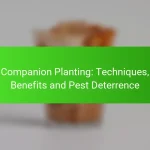Mulching is a vital practice for enhancing soil moisture retention, particularly in regions like South Africa where evaporation rates can be high. By applying various organic and inorganic materials to the soil surface, gardeners can significantly improve water infiltration, control weeds, and promote healthier soil. Selecting the appropriate mulching technique tailored to specific garden needs and local climate can lead to thriving plants and sustainable gardening practices.

How does mulching improve soil moisture retention in South Africa?
Mulching significantly enhances soil moisture retention in South Africa by reducing evaporation and promoting better water infiltration. This practice helps maintain a stable environment for plants, especially in regions with variable rainfall.
Reduces evaporation rates
Mulch acts as a barrier between the soil and the atmosphere, effectively minimizing water loss through evaporation. By covering the soil surface, it reduces direct sunlight exposure and wind impact, which are key factors in moisture loss.
In South Africa’s hot and dry climates, using organic mulches like straw or wood chips can lower evaporation rates by up to 50%. This is particularly beneficial during the dry season when water conservation is critical.
Enhances water infiltration
Mulching improves water infiltration by breaking up soil compaction and creating a more porous surface. This allows rainwater or irrigation to penetrate deeper into the soil, making it available to plant roots.
Using mulch can increase the rate at which water enters the soil, which is essential in areas prone to heavy rains followed by dry spells. Consider applying a layer of mulch that is 5 to 10 cm thick to optimize this effect.
Maintains consistent soil temperature
Mulch helps regulate soil temperature by insulating the ground, keeping it cooler in hot weather and warmer during cold nights. This temperature stability is crucial for root health and overall plant growth.
In South Africa, where temperature fluctuations can be significant, maintaining a consistent soil temperature can improve seed germination and reduce plant stress. Organic mulches, in particular, provide this benefit while also enriching the soil as they decompose.

What are the best mulching techniques for local gardens?
The best mulching techniques for local gardens include organic and inorganic options, each offering unique benefits for soil moisture retention and weed control. Choosing the right technique depends on your garden’s specific needs, local climate, and available materials.
Organic mulching with straw
Organic mulching with straw is a popular method that enhances soil moisture retention while adding nutrients as it decomposes. Straw is lightweight, easy to spread, and helps suppress weeds effectively.
When applying straw mulch, aim for a thickness of about 5 to 10 cm to maximize moisture retention without suffocating plants. Be cautious of using straw from grain crops, as it may contain weed seeds that could sprout in your garden.
Inorganic mulching with plastic
Inorganic mulching with plastic sheeting is an effective way to retain soil moisture and control weeds, particularly in vegetable gardens. Black plastic is commonly used as it absorbs heat, warming the soil and promoting early plant growth.
To use plastic mulch, lay it over prepared soil and secure it with soil or landscape staples. Ensure to cut holes for planting, and consider using biodegradable options if you prefer to minimize plastic waste in your garden.
Wood chip mulching
Wood chip mulching is another effective technique that provides excellent moisture retention and improves soil structure over time. This type of mulch is often sourced from local tree services and can be a sustainable choice for gardeners.
Apply wood chips in a layer of about 7 to 15 cm around plants, keeping the mulch away from plant stems to prevent rot. As wood chips break down, they enrich the soil, but be aware that they can temporarily tie up nitrogen, so consider supplementing with fertilizer if necessary.

What are the benefits of mulching for South African gardeners?
Mulching offers several advantages for South African gardeners, including moisture retention, weed control, and improved soil health. By applying organic or inorganic materials to the soil surface, gardeners can create a more favorable environment for plant growth.
Weed suppression
One of the primary benefits of mulching is its ability to suppress weeds. A thick layer of mulch blocks sunlight, making it difficult for weed seeds to germinate and grow. This reduces the need for chemical herbicides, promoting a healthier garden ecosystem.
For effective weed suppression, aim for a mulch depth of about 5 to 10 cm. Organic mulches, such as wood chips or straw, not only inhibit weeds but also break down over time, enriching the soil.
Soil erosion prevention
Mulching plays a crucial role in preventing soil erosion, especially in regions with heavy rainfall or strong winds. By covering the soil, mulch protects it from the impact of raindrops and wind, which can displace soil particles.
In South Africa, where certain areas are prone to erosion, using mulch can help maintain soil structure and prevent nutrient loss. Consider using heavier materials like gravel or stones in areas with steep slopes to enhance stability.
Improved soil fertility
Mulching contributes to improved soil fertility by adding organic matter as it decomposes. This process enriches the soil with essential nutrients, promoting healthier plant growth. Organic mulches, such as compost or grass clippings, can significantly boost soil quality over time.
To maximize fertility benefits, regularly refresh your mulch layer, ensuring it remains effective. A diverse mix of mulch materials can provide a broader range of nutrients, supporting various plant needs in your garden.

What materials are commonly used for mulching in South Africa?
In South Africa, various materials are utilized for mulching, each offering unique benefits for soil health and moisture retention. Common options include organic materials like grass clippings, shredded leaves, and compost, which help improve soil structure and fertility while conserving water.
Grass clippings
Grass clippings are a readily available and cost-effective mulching option. They decompose quickly, adding nitrogen to the soil and enhancing its fertility. When using grass clippings, ensure they are dry and free from chemicals to avoid harming plants.
Apply a thin layer, about 2.5 to 5 cm thick, to prevent matting, which can inhibit water penetration. Regularly monitor moisture levels beneath the mulch to maintain optimal conditions for plant growth.
Shredded leaves
Shredded leaves make an excellent mulch, providing organic matter and improving soil structure as they break down. They are abundant in autumn and can be collected easily from gardens and parks. Shredding the leaves helps them decompose faster and prevents them from blowing away.
Apply a layer of 5 to 10 cm for effective moisture retention. Be cautious of using leaves from trees treated with pesticides, as they may introduce harmful chemicals into the soil.
Compost
Compost serves as a nutrient-rich mulch that enhances soil fertility while retaining moisture. It is created from decomposed organic materials, making it a sustainable choice for gardeners. Compost can be purchased or made at home using kitchen scraps and yard waste.
Spread a layer of 2.5 to 7.5 cm around plants to provide both nutrients and moisture retention. Regularly check the compost for signs of decomposition and replenish as needed to maintain its effectiveness as a mulch.

How to choose the right mulch for your garden?
Choosing the right mulch for your garden involves considering the specific needs of your plants and the environmental conditions in your area. Different types of mulch offer various benefits, so understanding these factors will help you make an informed decision.
Consider plant types
Different plants thrive with different types of mulch. For example, organic mulches like wood chips or straw are beneficial for vegetable gardens as they improve soil quality over time. In contrast, inorganic mulches such as gravel or rubber are suitable for ornamental gardens, providing long-lasting coverage without decomposing.
When selecting mulch, consider the growth habits and moisture requirements of your plants. For moisture-loving plants, a thicker layer of organic mulch can help retain soil moisture, while drought-tolerant plants may benefit from a lighter application to prevent excess moisture retention.
Evaluate local climate
Your local climate significantly influences the effectiveness of different mulches. In hot, dry areas, organic mulches can help retain moisture and regulate soil temperature, while in cooler, wetter climates, they may decompose too quickly and require frequent replacement.
Consider seasonal changes as well. In regions with heavy snowfall, using a heavier mulch can protect plant roots from freezing temperatures. Conversely, in areas prone to high winds, lighter mulches may be displaced, so anchoring them properly is essential.










